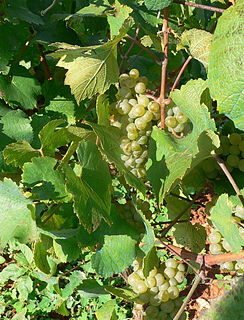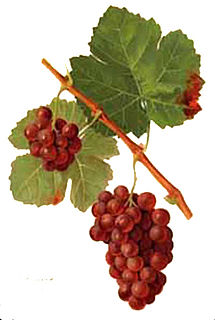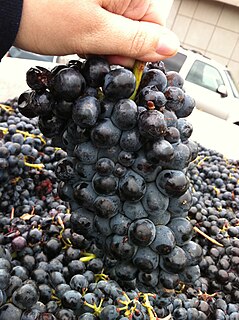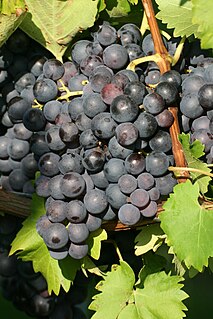
Merlot is a dark blue–colored wine grape variety, that is used as both a blending grape and for varietal wines. The name Merlot is thought to be a diminutive of merle, the French name for the blackbird, probably a reference to the color of the grape. Its softness and "fleshiness", combined with its earlier ripening, makes Merlot a popular grape for blending with the sterner, later-ripening Cabernet Sauvignon, which tends to be higher in tannin.

Chardonnay is a green-skinned grape variety used in the production of white wine. The variety originated in the Burgundy wine region of eastern France, but is now grown wherever wine is produced, from England to New Zealand. For new and developing wine regions, growing Chardonnay is seen as a 'rite of passage' and an easy entry into the international wine market.

Cabernet Sauvignon is one of the world's most widely recognized red wine grape varieties. It is grown in nearly every major wine producing country among a diverse spectrum of climates from Australia and British Columbia, Canada to Lebanon's Beqaa Valley. Cabernet Sauvignon became internationally recognized through its prominence in Bordeaux wines where it is often blended with Merlot and Cabernet Franc. From France and Spain, the grape spread across Europe and to the New World where it found new homes in places like California's Santa Cruz Mountains, Paso Robles, Napa Valley, New Zealand's Hawke's Bay, South Africa's Stellenbosch region, Australia's Margaret River, McLaren Vale and Coonawarra regions, and Chile's Maipo Valley and Colchagua. For most of the 20th century, it was the world's most widely planted premium red wine grape until it was surpassed by Merlot in the 1990s. However, by 2015, Cabernet Sauvignon had once again become the most widely planted wine grape, with a total of 341,000 hectares (3,410 km2) under vine worldwide.

Syrah, also known as Shiraz, is a dark-skinned grape variety grown throughout the world and used primarily to produce red wine. In 1999, Syrah was found to be the offspring of two obscure grapes from southeastern France, Dureza and Mondeuse Blanche. Syrah should not be confused with Petite Sirah, a cross of Syrah with Peloursin dating from 1880.

Malvasia is a group of wine grape varieties grown historically in the Mediterranean region, Balearic Islands, Canary Islands and the island of Madeira, but now grown in many of the winemaking regions of the world. In the past, the names Malvasia, Malvazia, and Malmsey have been used interchangeably for Malvasia-based wines; however, in modern oenology, "Malmsey" is now used almost exclusively for a sweet variety of Madeira wine made from the Malvasia grape. Grape varieties in this family include Malvasia bianca, Malvasia di Schierano, Malvasia negra, Malvasia nera, Malvasia nera di Brindisi, Malvasia di Candia aromatica, Malvasia odorosissima, and a number of other varieties.

Aurore is a white complex hybrid grape variety produced by Albert Seibel and used for wine production mostly in the United States and Canada. Over a long lifetime Seibel produced many complex hybrid crosses of Vitis vinifera to American grapes. It is a cross of Seibel 788 and Seibel 29.

Pinot blanc is a white wine grape. It is a point genetic mutation of Pinot noir. Pinot noir is genetically unstable and will occasionally experience a point mutation in which a vine bears all black fruit except for one cane which produces white fruit.

Carignan is a red grape variety of Spanish origin that is more commonly found in French wine but is widely planted throughout the western Mediterranean and around the globe. Along with Aramon, it was considered one of the main grapes responsible for France's wine lake and was a substantial producer in jug wine production in California's Central Valley but in recent years, it has been reborn as a flagship wine for many cellars in the south of France as well as in Catalonia.

Gewürztraminer is an aromatic wine grape variety, used in white wines, and performs best in cooler climates. In English, it is sometimes referred to colloquially as Gewürz, and in English and French it is written Gewurztraminer. Gewürztraminer is a variety with a pink to red skin colour, which makes it a "white wine grape" as opposed to the blue to black-skinned varieties commonly referred to as "red wine grapes". The variety has high natural sugar and the wines are white and usually off-dry, with a flamboyant bouquet of lychees. Indeed, Gewürztraminer and lychees share the same aroma compounds. Dry Gewürztraminers may also have aromas of roses, passion fruit and floral notes. It is not uncommon to notice some spritz.

Barbera is a red Italian wine grape variety that, as of 2000, was the third most-planted red grape variety in Italy. It produces good yields and is known for deep color, full body, low tannins and high levels of acidity.

The Muscat family of grapes includes over 200 grape varieties belonging to the Vitis vinifera species that have been used in wine production and as raisin and table grapes around the globe for many centuries. Their colors range from white, to yellow, to pink to near black. Muscat grapes and wines almost always have a pronounced sweet floral aroma. The breadth and number of varieties of Muscat suggest that it is perhaps the oldest domesticated grape variety, and there are theories that most families within the Vitis vinifera grape variety are descended from the Muscat variety.

Blaufränkisch is a dark-skinned variety of grape used for red wine. Blaufränkisch, which is a late-ripening variety, produces red wines which are typically rich in tannin and may exhibit a pronounced spicy character.

Trollinger, Schiava, or Vernatsch, is a red German/Italian wine grape variety that was likely first originally cultivated in the wine regions of South Tyrol and Trentino, but today is almost exclusively cultivated on steep, sunny locations in the Württemberg wine region of Baden-Württemberg. It is primarily known under the synonyms Trollinger in Germany, Vernatsch in South Tyrol and Schiava in other Italian regions. As a table grape the variety is sometimes known as Black Hamburg, which is commonly confused with the similar synonym for Black Muscat—a variety that is actually a cross of Trollinger and Muscat of Alexandria.

Gouais blanc or Weißer Heunisch is a white grape variety that is seldom grown today but is important as the ancestor of many traditional French and German grape varieties. The name Gouais derives from the old French adjective ‘gou’, a term of derision befitting its traditional status as the grape of the peasants. Likewise, the German name Weißer Heunisch labels it as one of the lesser "Hunnic" grapes.

Hybrid grapes are grape varieties that are the product of a crossing of two or more Vitis species. This is in contrast to crossings between grape varieties of the same species, typically Vitis vinifera, the European grapevine. Hybrid grapes are also referred to as inter-specific crossings or "Modern Varieties." Due to their often excellent tolerance to powdery mildew, other fungal diseases, nematodes, and phylloxera, hybrid varieties have, to some extent, become a renewed focus for European breeding programs. The recently developed varieties, Rondo, and Regent are examples of newer hybrid grape varieties for European viticulturalists. Several North American breeding programs, such as those at Cornell and the University of Minnesota, focus exclusively on hybrid grapes, with active and successful programs, having created hundreds if not thousands of new varieties.

The Geisenheim Grape Breeding Institute was founded in 1872 and is located in the town of Geisenheim, in Germany's Rheingau region. In 1876 Swiss-born professor Hermann Müller joined the institute, where he developed his namesake grape variety Müller-Thurgau, which became Germany's most-planted grape variety in the 1970s. Professor Helmut Becker worked at the institute from 1964 until his death in 1989.
This glossary of viticultural terms list some of terms and definitions involved in growing grapes for use in winemaking.

Incrocio Manzoni or Manzoni grapes is a family of grape varieties named after Professor Luigi Manzoni (1888-1968) of Italy's oldest school of oenology located in Conegliano, in the Veneto region. Manzoni created the new grape varieties by selecting, crossing and grafting vines from various vineyards during the 1920s and 1930s. The family includes both white and red grape varieties. Although most Manzonis are grown in northeastern Italy, they are mainly grown in the Piave area of Province of Treviso and are only now starting to be sold commercially in Europe and the United States.
Alicante Ganzin is a red French wine grape variety. Unlike most Vitis vinifera wine grapes, Alicante Ganzin is a teinturier with dark flesh that produces red juice. Most varieties used to produce red wine, such as Cabernet Sauvignon, Syrah, etc., have clear color flesh and juice with the wine receiving its color through a maceration process where the color seeps out of the grape skins for as long as they are in contact with the juice. Alicante Ganzin can thus produce light red and rose colored wine without maceration. It is believed that Alicante Ganzin is often described as the progenitor of all French teinturier grapes.
Manto negro is a red Spanish wine grape variety grown on the Balearic islands. It is used in wines produced under the Binissalem-Mallorca and Plà i Llevant (DO) Denominación de Origen (DO)s, as well as the Illes Balears appellations. Today, Manto negro is almost exclusively found on the island of Majorca with 320 hectares, making it the most widely planted grape variety on the island. It represents over 20% of the total vineyard land in production. Although planted throughout the island, the vine seems to be more successful in the rocky soils of the western Binissalem region.

















